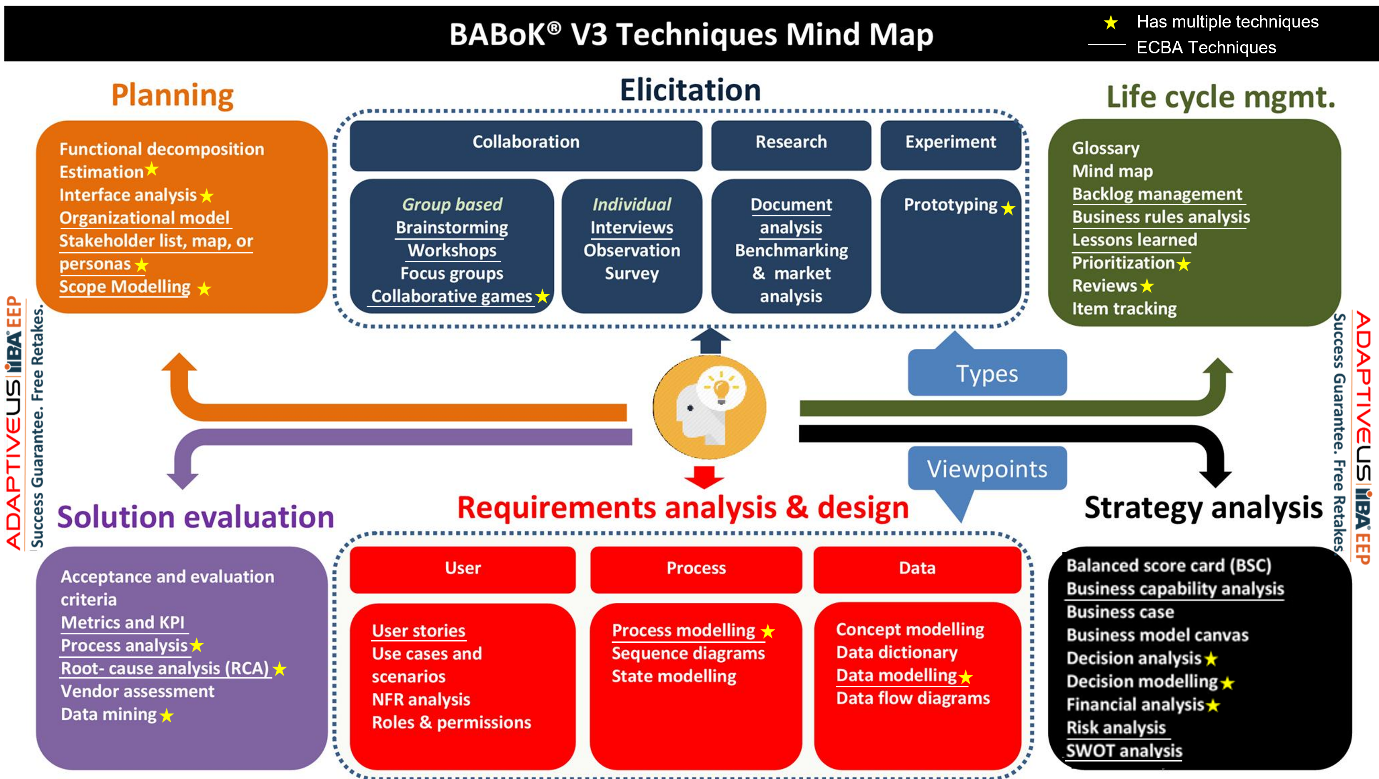ECBA Exam Update 2025: Twenty Techniques in Focus
The International Institute of Business Analysis (IIBA) has refreshed the Entry Certificate in Business Analysis (ECBA) exam from July 2025, and one of the most thoughtful changes is the reduction of BABOK techniques from 50 to just 20. This change aligns the exam more closely with the foundational techniques new business analysts use in their day to day activities.
For ECBA aspirants, it means less overwhelm and more focus — you’ll now study the most practical and frequently applied techniques from the BABOK® Guide v3.
Why Did IIBA Reduce the Number of Techniques?
In the past, ECBA candidates had to familiarize themselves with all 50 techniques from BABOK — an extensive list that included everything from Backlog Management to Root Cause Analysis. While comprehensive, it often felt overwhelming for beginners who were new to business analysis.
The IIBA’s new approach makes the ECBA:
✅ Focused – Streamlines foundational learning by removing advanced techniques better suited for CBAP / CCBA levels.
✅ Relevant – Focuses on tools early-career analysts will apply in real-world projects.
✅ Practical – Emphasizes analysis, modeling, stakeholder engagement, and value measurement.
In short, the new exam is designed to test understanding, not memorization — preparing you for hands-on business analysis success.
The 20 BABOK Techniques You Need to Know for ECBA
Let’s explore the 20 techniques that now form the foundation of the ECBA exam.
1. Backlog Management
Used primarily in Agile environments, this technique helps BAs prioritize, track, and refine requirements in a dynamic list known as a backlog. You’ll learn to manage evolving user needs and ensure high-value items are delivered first.
Strengths
Keeps team focused on high-priority items, supports iterative detail elaboration, and enables flexible response to changing needs.
Limitations
Large backlogs can be unwieldy and difficult to manage; risk of losing details if items are not updated timely.
2. Brainstorming
A creative group activity that encourages stakeholders to generate ideas and solutions collaboratively. This is highly useful for identifying possible requirements, risks, or solution approaches.
Strengths
Fun, productive, and can generate many ideas quickly while reducing tension between participants.
Limitations
Dependent on participants' creativity and willingness, and requires agreement to avoid criticism during sessions.
3. Business Capability Analysis
Helps identify what an organization does well and where it needs to improve. It’s used to assess existing strengths and gaps in organizational capabilities to meet business goals.
Strengths
Minimizes waste and creates aligned initiatives by providing shared strategic outcomes.
Limitations
Requires cross-functional collaboration; deciding the approach and level of rigor can be challenging.
4. Business Rules Analysis
Involves identifying, defining, and documenting business policies, rules, and constraints that influence business behavior or system functionality.
Strengths
Centralized repository enables rule reuse; supports quick implementation of changes without altering processes.
Limitations
Poor vocabulary or contradictory rules can produce errors; combined rules may result in inconsistent outcomes.
5. Collaborative Games
Engaging, structured activities that promote stakeholder collaboration and creative problem-solving. Examples include role-playing or innovation games that surface hidden needs and priorities.
Strengths
Encourages creative thinking and helps surface hidden assumptions; promotes active participation.
Limitations
Some may find it unproductive or uncomfortable, especially reserved participants.
6. Data Modelling
A visual representation of data and its relationships — crucial for defining how data is structured, stored, and used across systems.
Strengths
Ensures consistent vocabulary and logical design for persistent data; facilitates transparency.
Limitations
Requires technical knowledge often beyond typical stakeholder expertise.
7. Document Analysis
A technique for reviewing existing documentation such as process manuals, reports, or system specs to uncover useful information or requirements.
Strengths
Useful when subject matter experts are unavailable; provides AS-IS perspective without creating new content.
Limitations
Dependent on accuracy and currency of documents; results may be time-consuming to analyze and validate.
8. Interviews
One of the most fundamental BA techniques — it involves one-on-one or group conversations with stakeholders to elicit detailed information, clarify needs, or validate understanding.
Strengths
Builds rapport, allows probing and clarification, and supports in-depth examination of stakeholder perspectives.
Limitations
Time-consuming, requires skilled facilitators, and can be influenced by interviewer’s bias.
9. Lessons Learned
Captures insights, successes, and challenges from past projects to improve future performance.
This fosters continuous improvement and organizational learning.
Strengths
Promotes team morale, reinforces positive experiences, and reduces risks for future projects.
Limitations
Can devolve into blame discussions if not well facilitated; reluctance among team members to discuss problems openly.
10. Metrics and Key Performance Indicators (KPIs)
Defines quantitative measures used to evaluate the success of a solution or process. Examples include cost savings, defect rates, or customer satisfaction scores.
Strengths
Facilitates alignment of goals and objectives; provides clear measures for performance management.
Limitations
Can be resource-intensive and may distract from core responsibilities, especially in agile environments.
11. Organizational Modelling
Visually depicts the structure, roles, and relationships within an organization. Helps identify who performs which functions and where communication bottlenecks may exist.
Strengths
Visual representation of organizational units is common and enables future projects to know participants and their roles.
Limitations
Can become outdated and does not always reflect real influencers within the organization.
12. Process Analysis
Focuses on understanding and improving business processes. It helps identify inefficiencies, redundancies, or gaps that may affect productivity or quality.
Strengths
Ensures solutions address the right issues and aligns initiatives organization-wide.
Limitations
Can be time-consuming with no standardized notation for capability maps.
- Process Modelling
Creates task sequences using activity diagrams and BPMN models to illustrate business processes — essential for identifying areas for automation or optimization.
Strengths
Enhances understanding for most stakeholders and supports training and coordination.
Limitations
Formal models can become documentation-heavy and may be perceived as cumbersome.
14. Risk Analysis and Management
Identifies potential risks, their causes, and mitigation strategies to ensure smooth delivery of business initiatives.
Strengths
Allows management of risks at multiple levels and sharing of successful responses across initiatives.
Limitations
Full list of risks may be unmanageably large; often possible to manage only a subset at a time.
15. Root Cause Analysis
Used to find the underlying causes of a problem rather than just treating its symptoms.
Techniques like the 5 Whys or Fishbone Diagram are commonly applied.
Strengths
Structured methods aid in identifying root issues and enable effective solutions.
Limitations
Requires extensive experience to facilitate and may be difficult with complex problems.
👉 [Download the Root Cause Analysis Template]
16. Scope Modelling
Clarifies what’s included and excluded from an initiative. It’s often depicted using context diagrams or boundaries to align stakeholders on project scope.
Strengths
Provides justification for in-scope/out-of-scope decisions and helps assess completeness and solution impact.
Limitations
Political and contractual constraints can make scope change challenging; wrong assumptions may affect scope as needs change.
17. Stakeholder List, Map, or Personas
A vital technique for identifying all individuals or groups affected by the change. Helps BAs analyze stakeholder influence, needs, and engagement strategies.
Strengths
Useful for requirements elicitation and stakeholder engagement across groups.
Limitations
Complex and risky to assess influence and interest of stakeholders; can be less used by teams with stable stakeholders.
18. SWOT Analysis
A classic technique that evaluates an organization’s Strengths, Weaknesses, Opportunities, and Threats — used to frame strategy and make informed business decisions.
Strengths
Quickly analyzes multiple aspects of state and environment; helps focus on value-adding factors.
Limitations
High-level only; requires further analysis and clear context to avoid drifting from focus.
19. User Stories
Short, simple descriptions of a feature from the end user’s perspective, typically written as: “As a [user], I want [goal] so that [benefit].” They’re widely used in Agile environments to express business needs concisely.
Strengths
Easily understood and supports prioritizing, estimating, and planning solutions.
Limitations
May lack detailed specifications and requires proper context for complete understanding.
20. Workshops
Facilitated sessions that bring together key stakeholders to collaborate, prioritize, and validate requirements, designs, or decisions in real time.
Strengths
Efficient for collecting detailed requirements and validating inputs, direct stakeholder collaboration, and cost efficiency compared to multiple interviews.
Limitations
Process can slow down with too many participants; facilitation and complete input collection are required to prevent overlooked requirements.
What This Means for ECBA Exam Preparation
This change brings good news for ECBA aspirants:
- Reduced Study Load: You now focus on 20 essential techniques instead of covering 50.
- Better Depth Over Breadth: You can invest more time understanding when and how to apply each technique.
- More Practical Questions: Expect situation-based questions testing application, not rote recall.
- Efficient Study Time: Preparation time may reduce by 20–25%, making the exam more approachable.
✅ How to Prepare Smartly
- Group techniques by their use cases (Elicitation, Analysis, Validation, etc.).
- Practice identifying which technique fits which situation.
- Use BABOK summaries, flashcards, and real-world case examples.
- Enroll in a course that includes updated ECBA mock tests reflecting the new pattern.

Adaptive US ECBA Techniques Mindmap
Final Thoughts
The ECBA exam update is a positive and learner-friendly evolution by IIBA. By focusing on the most relevant and high-impact techniques, it ensures that new business analysts are equipped with practical, industry-ready skills.
Whether you’re a student, career changer, or aspiring BA, mastering these 20 techniques will give you a strong foundation for success — both in the ECBA exam and in your professional journey.
Ready to ace the ECBA 2025 exam?
Join the Adaptive US ECBA Certification Training – updated for the latest IIBA syllabus, complete with interactive exercises, video lessons, and 1,000+ mock questions to help you succeed with confidence.
You May Also Like
These Related Stories

CCBA Certification Exam Preparation in 2025

IIBA Certifications Process - A Step by Step Approach


No Comments Yet
Let us know what you think